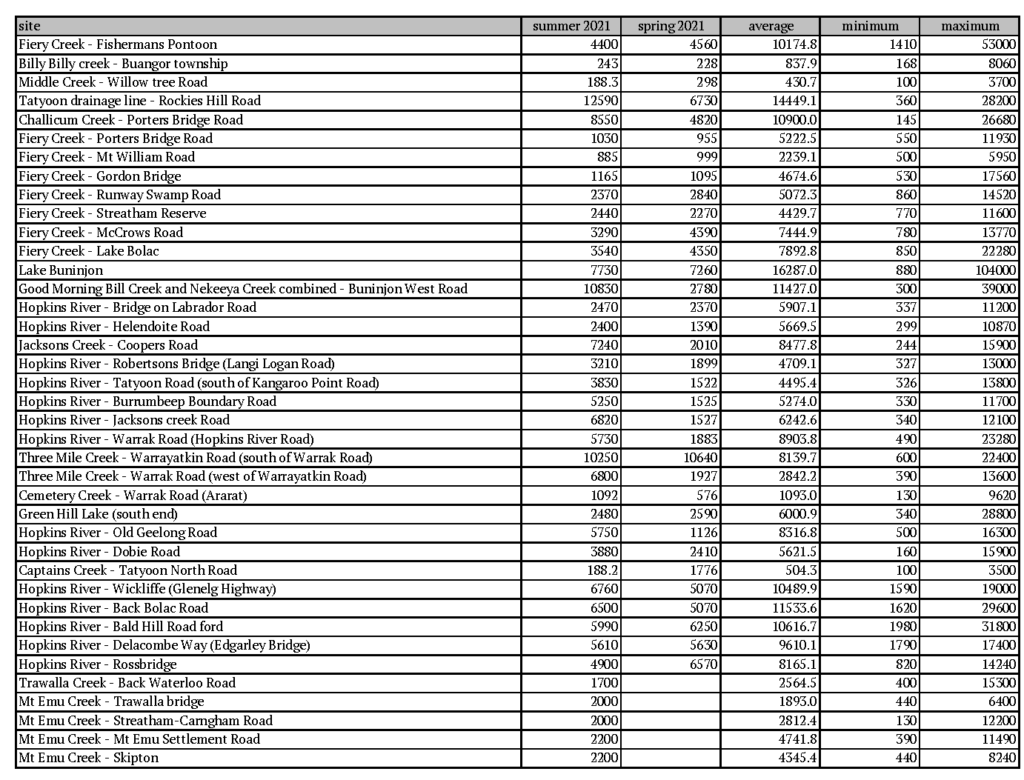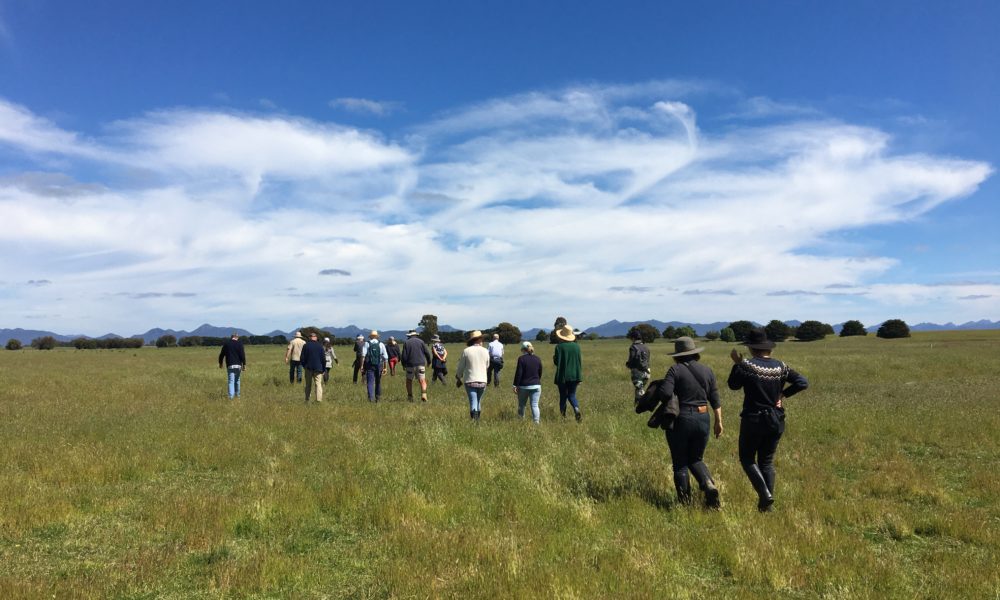Landcare news and opportunities
Opportunities and awards
- Future Drought Fund: Resilient Soils and Landscapes: The Future Drought Fund provides a sustainable source of funding to help Australian farmers and agricultural-dependent communities and businesses become more prepared for and resilient to the impacts of drought. https://www.communitygrants.gov.au/grants/drought-resilient-soils-and-landscapes-grants-program
- Celebrating Women in Conservation Breakfast 2022: The 11th annual Celebrating Women in Conservation Breakfast will be held on Thursday 3 March 2022. Join in online at home or gather together with some other local women for breakfast (contact Facilitator@UpperHopkins.org.au to register your interest).
Information and Resources
- Victorian Landcare Awards: The latest issue of the Victorian Landcare Magazine is a feature on the 2021 Victorian Landcare Awards, including our own Don Rowe! Read all about it online at https://www.landcarevic.org.au/landcare-magazine/spring-2021/
- Soil carbon needs technology: This is an interesting opinion piece from the Soil CRC about how Australian farmers could contribute to capturing soil carbon: https://soilcrc.com.au/soil-carbon-sequestration-needs-technology/
- What’s happening in Glenelg Hopkins CMA Keep up to date with news from our local Catchment Management Authority. Go to https://www.ghcma.vic.gov.au/whats-happening/ for newsletters, podcasts and other regional updates.
- Inquiry into ecosystem decline in Victoria: The Environment and Planning Committee has made a total of 74 recommendations to address the range of problems associated with Victoria’s declining ecosystem. Read the report here: https://www.parliament.vic.gov.au/epc-lc/article/4455
Webinars and podcasts
- Farm dams webinar recording now available: Two ecologists, Dave Smith and Angelina Siegrist, covered some of the latest research on the biodiversity and productivity benefits of enhancing farm dams, and introduced Enhancing farm dams: What to plant in and around your dam, a new guide from ANU Sustainable Farms. Guest speaker Sally Day from Greta Valley Landcare shared her experiences of why farmers choose to enhance their dams, and practical aspects of planning a farm dam project. Watch the video online.
- Cattle production in a changing climate: As Australian summers get hotter and longer with more extreme weather events, what impact will this have on our livestock? Why is heat stress becoming more of an issue for Australian farmers? What strategies exist and are emerging to deal with the rising temperatures? RSVP now: https://farmersforclimateaction.org.au/portfolio/impacts-of-climate-change-on-cattle/
- Five soil podcasts: Find out more about soil health, soil carbon and some Soil CRC projects while you are harvesting, driving or getting jobs done this week: https://soilcrc.com.au/4831-2/
- Soil carbon sequestration: how will it work? Watch or listen to this discussion featuring Louisa Kiely, director of Carbon Farmers of Australia, and Dr Michael Crawford, CEO of the Soil CRC, as they investigate the soil carbon landscape, the technology and policy needed to increase soil carbon sequestration, and the potential for agriculture if it is increased. https://soilcrc.com.au/soil-carbon-sequestration-how-will-it-work/
- South West Biodiversity Forum 2021: Catch up on regional biodiversity news and research in Gunditj Mirring and Easter Maar Country. https://www.swifft.net.au/cb_pages/south_west_biodiversity_forum.php

From the President’s Desk – AGM report

Jack Tucker, President
The past 12 months has had its obvious challenges with COVID but in a way it has probably created an opportunity for people to slow down, take stock and seriously consider getting on with Landcare projects. This has been evident with the level of enquiry we have received around grant opportunities over the last couple of years.
I would like to begin by thanking Ayesha who has now completed her second year in the facilitator role. As you will have seen in her report she has been working on a number of initiatives that are benefiting, and will benefit members of our group.
Ayesha’s facilitator position has recently been successfully funded for the 2021/22-23/24 period by DELWP. Thank you very much to Kelly Gellie and CC for the huge contribution they made to ensure the UHLMG, Ararat Landcare Group and Ararat Biolinks Network were successful in securing this funding, which can at best be described as a monumental task!
DELWP did not allow us to continue using Skillinvest to assist us with Ayesha’s employment (which has been the arrangement since our Group first started employing a facilitator) so Kelly did a great job restructuring Ayesha’s employment arrangements so that UHLMG now takes care of all aspects of her employment.
We have been successful in receiving Vic Landcare Grants for 2021/22. Unfortunately, no Victorian Landcare Grants were on offer in 2020/21 so it was very exciting to recently be informed by the Glenelg Hopkins CMA that a range of landcare projects will be funded in our region over the next 12 months.
I should highlight how supportive Ayesha has been of those who have received funds by doing site visits and preparing their applications which has shone through in this round of funding.
The UHLMG committee handbook prepared by Moores Legal in 2020 is another great outcome for the Group. This handbook has provided our Committee with a resource that will assist us with ensuring that the UHLMG applies good governance in all aspects of the service that we deliver to our community going forward. There are a number of associated policies that Ayesha and members of the Committee (namely CC and Kelly) have developed that are included as Appendices in the Handbook document.
The Soil Health subcommittee was formed in 2020 and it has been great to hear about some of the initiatives that are starting to come to fruition as a result of this committee. Thank you Jayne Drum, Sarah Whinney, CC Tucker for working with Ayesha to come up with some great ideas for the future. I would also like to welcome Leila McDougall who has recently joined this subcommittee, we will look forward to her contribution.
IPM day recently held at the Burdetts is one activity that resulted from the soil health subcommittee discussions and was a great opportunity for local agronomists and farmers alike to draw on the vast knowledge and experience of well-known Ag entomologist Paul Horne.
The Biggest Little Farm film night was another successful event dreamt up by the Soil Health committee with a full house. A big shout out to Jayne Drum, Sarah Whinney, Celia Tucker, Robin Tait and Ayesha Burdett for organising that event. And to Craig Drum and Howard Brandenburg for helping out with the technology.
Next I would like to thank Kelly, who has just completed her second year in her role as treasurer for the group. Her skill and experience in accounting is of tremendous benefit to us and she has done a great job with the 2020/21 financial report which has been audited by Mulcahy and Co.
Once again thank you to Celia for her dedication and countless hours of work as Secretary which I get to see firsthand.
Succession planning is something the committee has discussed quite a bit and needs to be addressed over the next couple of years so that the Group remains dynamic into the future. New blood plays an important role in achieving this. The renewal of the UHLMG Strategic Plan is scheduled to be completed by the end of 2021/22 and this will be a great opportunity to delve into this topic as well as determine our key focuses for the 2022-24 period. We are currently finalising an independent person to facilitate this process for us and we have secured funding for this purpose.
In Landcare terms the last 12 months have been very positive – It is exciting to get new members on board and the level of enquiry around Landcare related projects has been exceptional.
As always, I will finish my report by reminding everyone to encourage others to join the committee as it is important that we continue to have people with a diverse range of experience and skills leading the group. Alternatively, if members of our Group have a particular interest we would welcome their input big or small.
Happy Landcaring!
Jack
Australian Government Individual Landcare Award

Local Landcarer, Don Rowe, has won the prestigious Australian Government Individual Landcare Award. This award acknowledges the significant contribution made by an individual who has demonstrated outstanding leadership and commitment to Landcare.
Don will represent Victoria at the 2022 National Landcare Awards. The award was announced last week at the Victorian Landcare Award Ceremony.
Don Rowe is a local landholder, community member and leading Landcarer in the Upper Hopkins region. He has been active in the Upper Hopkins Land Management Group (Upper Hopkins LMG) since it formed in 1991, helping to guide the strategic direction of the group under the banner of mitigating and adapting to climate change.
Upper Hopkins LMG President, Jack Tucker, congratulated Don for his award.
“It’s fantastic to see Don win this award. His work over the years has really paid off and we can all see his impact on the landscape and the community.”
Well before UHLMG was formed, Don and his wife Goldie were erecting land class fencing and planting biodiversity corridors on their property, transforming the agricultural landscape. Many of the new trees and shrubs were grown from seed Don had collected. He also pioneered the use of direct seeding in the region as a way of sowing large areas with indigenous trees with excellent results.
Don and Goldie have hosted numerous paddock walks, field days and social gatherings for UHLMG on their property. Don is an important mentor and role model for other farmers who share his commitment to soil health and sustainable farming, as well as enhancing indigenous vegetation, protecting wetlands and waterways, and controlling pest plants and animals.
As a teacher at Ararat Secondary College, Don promoted sustainable farming practices and organised students to work on many tree planting projects from Elmhurst to Tatyoon.
“I think every landowner should have a revegetation project that they work on each year. The benefits are well known and, with the immediate threat of climate change, it is one thing we can all do. Many of us despair at the lack of leadership in tackling the impending climate crisis but we can all make an effort to improve our small part of the planet.”
UHLMG’s greatest challenge is responding to climate change. Don has represented the interests of UHLMG members to promote sustainable and practical responses to climate change in the region. He has worked with the Ararat Rural City Council Environmental Sustainability Advisory Group, the Environmental Sustainability Advisory Committee, Glenelg Hopkins CMA Community Advisory Group, the Upper Hopkins Stakeholder Group convened by Ararat Rural City Council and Ararat Greenhouse Action Group. His approach to strategic planning is pragmatic and realistic, recognising that Landcare members are volunteers with many other roles and responsibilities.
The region is facing rural population decline. As farm sizes increase, neighbours get further away and it can be challenging for people to connect. Don has led the UHLMG in engaging with the community and supporting and encouraging new landholders. Don is a regular contributor to the UHLMG newsletter, reaching more than 400 subscribers and often pens letters to the editor of the local newspaper on environmental and climate change issues.
Don has worked tirelessly at the Maroona Reserve, adjacent to the Hopkins River, planting trees and controlling weeds with the local primary school.
His positive can-do attitude is an inspiration for all who know him.
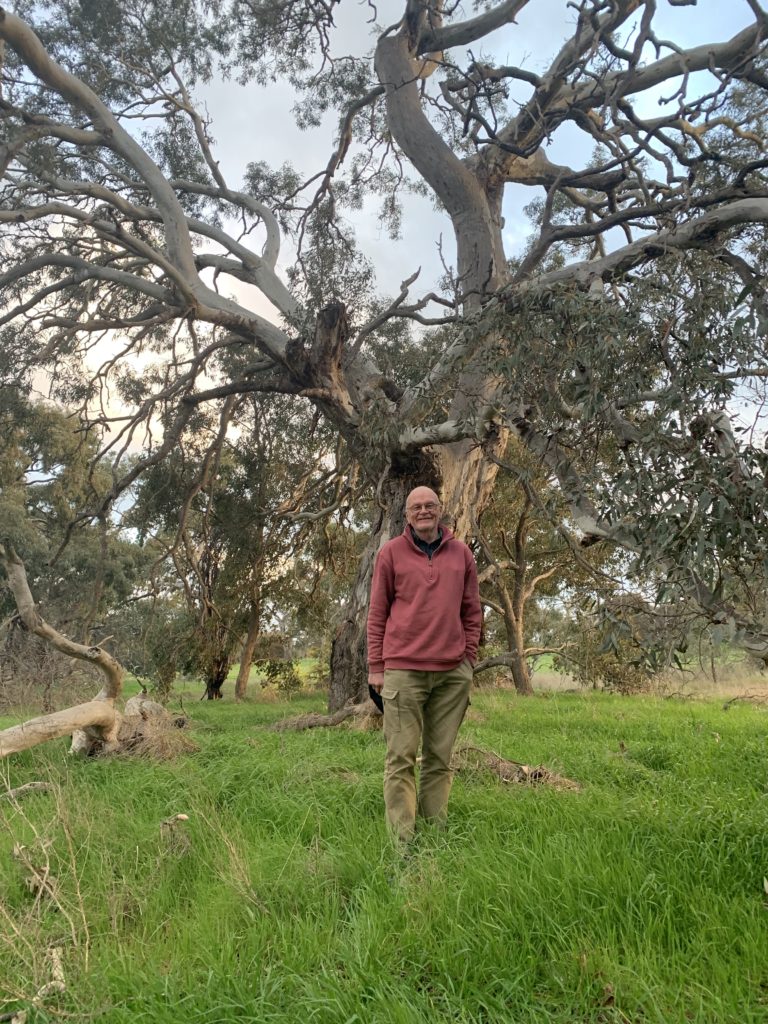
Don Rowe encourages us all to keep revegetating and putting trees in the ground to act on climate change. (Photo: Celia Tucker)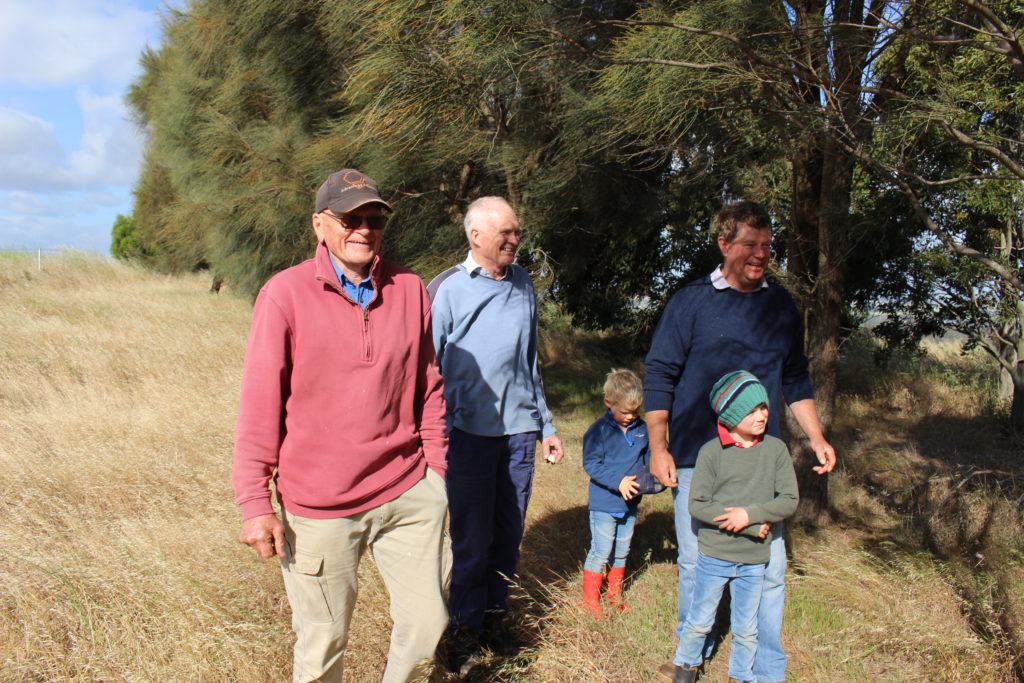
Don Rowe celebrated his Landcare Award with a walk along one of his biodiversity corridors. Joining him was Tim Johnstone and Upper Hopkins LMG President Jack Tucker with Johnny and James. (Photo: Ayesha Burdett)
Secretary’s report

Celia Tucker, Secretary
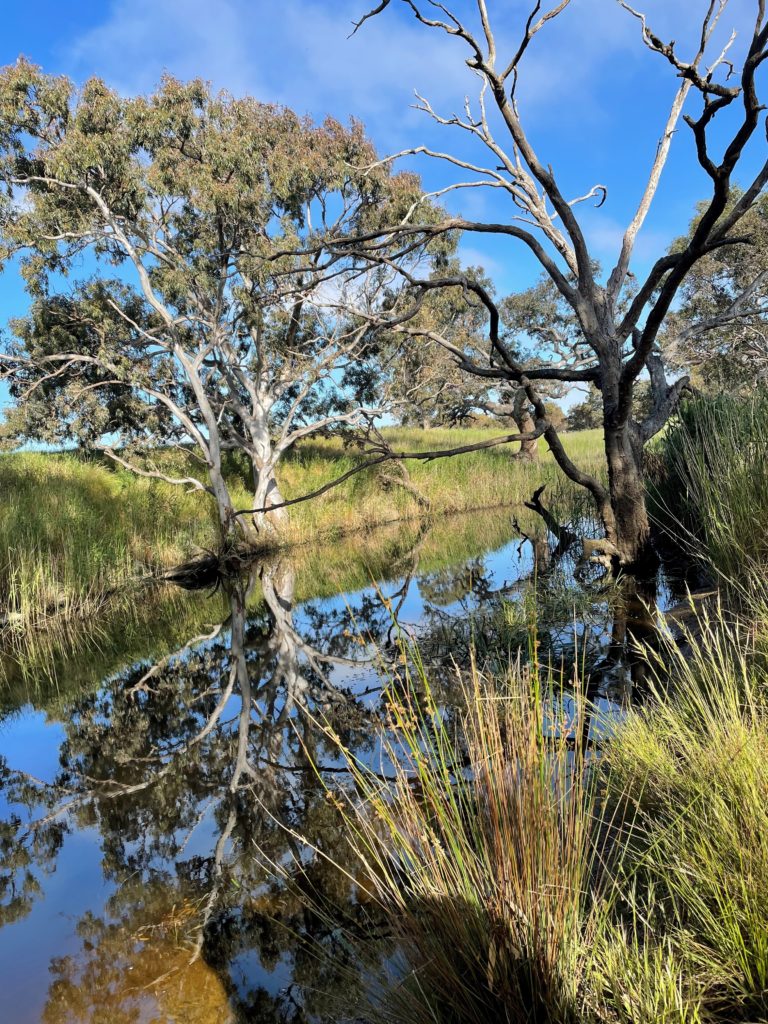
Having secured funding from the Department of Environment, Land, Water and Planning (DELWP) through the Victorian Landcare Facilitator Program (VLFP) for another 3 years for Ayesha’s position and plans being finalised to engage an independent person to assist us with completing a Strategic Plan for the 2022-24 period the Upper Hopkins Land Management Group is in a strong position as we start to plan for 2022.
At our recent AGM we welcomed two new committee members, being Richard Franc and Heidi Rees. Both are enthusiastic Landcarers and it is really exciting to have new faces willing to assist with the future direction of the Group. We very much look forward to working with them both.
Our financial membership list is looking as strong as ever with a handful of new members in 2021/22 so thank you to everyone who renewed their membership or signed up in recent times.
The Soil Health team have been busy throughout 2021 and there are some exciting events and initiatives planned for 2022. Thank you to Jayne Drum, Sarah Whinney, Ayesha Burdett and more recently Leila McDougall for your input. Understandably there is a lot of attention being paid to soil at the moment as politicians look closely at how they can better support farmers to continue improving soil health and in turn sequester higher levels of carbon. The soil health team will continue to look for funding opportunities and develop initiatives that support UHLMG members in this space.
A big congratulations to Don Rowe, our Vice President, who won the Australian Government Individual Landcarer Award at the Victorian Landcare Awards ceremony held on the 26th November. It was really exciting to see Don recognised for his contribution and leadership in the Landcare space over a very long period of time. Don and Goldie have created a network of biodiversity corridors across their entire property and it is a great example of how a farm business can be productive whilst also ensuring there are ecological benefits.
As always a big thank you to Ayesha for preparing another excellent newsletter and to everyone that has contributed in some way. Don’t forget if you ever have a Landcare related photo, observation to report or an article that you would like to submit for future newsletters please send them through to Ayesha. We love to hear from as many people throughout our region.
Wishing you all a safe and enjoyable time over the Christmas period and I hope the weather is kind to those of you who are harvesting crops. What an amazing season it’s been!
Cheers,
Celia
Ararat Landcare Group – Annual General Meeting
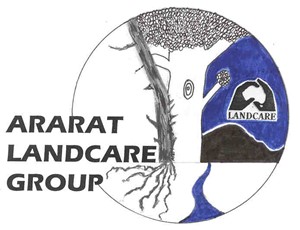
The Annual General Meeting of the Ararat Landcare Group was held on Monday 8th November 2021. Office bearers were elected, with Russell Pearse continuing in the role of President. Russell will continue to be supported by Jim Stringer (Secretary) and John Mawson (Treasurer).
Local nursery owner, Allison Barr, joined the group to introduce them to Keringle Native Nursery.
Allison has been operating the nursery since April 2021. The nursery mainly grows tubestock and focuses on trees.She encouraged everyone to visit the site at Yalla-Y-Poora to see trees in the ground as well as in the nursery. The nursery has recently expanded to employ two staff, host work experience students and provide a gardening service.
Allison demonstrated “maxi beast tree guards”. They are very tall, corflute guards that are held in place by a wooden stake and a sturdy bamboo stake. They are tall enough to protect the growing tree from sheep and kangaroos. Additionally, the corflute protects the plants from cold wind and frost, acting like a greenhouse and encouraging rapid growth.
The Ararat Landcarers were impressed by the business and congratulated Allison on her efforts.
President’s report
I’m pleased to be able to report that 2021 is finishing on a much more positive note- generally- than the same time last year, when activities were quite constrained and interaction was limited.
We managed to be involved in Clean Up Australia Day again, and working bees have been continuing on a regular basis, and I thank all the members who have been turning up for these activities regularly- monitoring previously worked areas and prioritising new ones for weeds and rubbish.
We have made a new connection with Parks Victoria in relation to Ararat Regional Hills Park- one which will likely take time to see much action there as resources are limited but we can at least help to provide input to future developments and maintenance.
Street trees continue to be a source of disappointment, with trees still being removed without the promised consultation, while we still await the outcome a grant application which would give us an opportunity to inform Council’s Street Tree program. Also, Council have still not re-constituted an ARCC environmental consultation group. That group is now about 2 years behind in re-forming.
The Ararat College wetland project has gone quiet but we continue to encourage their collaboration with ALG.
A recent request for help with planting at Greenhill Lake has been embraced enthusiastically by members, and will enable us to show the depth of knowledge and skill that we have to offer.
Thank you to all members for continuing your involvement, including the now regular articles on local weeds, new signage on the Cemetery Creek Walking Track, regular working bees, and especially to Ayesha for keeping us all on track with lots of resources and connections to the wider network.
Brolga (Antigone rubicunda) movement behaviour and habitat use
Did you miss out on attending the Upper Hopkins LMG Annual General Meeting? We had a great presentation from Dr Inka Veltheim, who described her research in the region. This was a great warm-up for the paddock walk the following day. Click below to watch Inka’s presentation now.
Many thanks to Inka for sharing her knowledge and enthusiasm with us, and to all of the landholders who host brolgas on their farms.
Looking ahead to 2022

Ayesha Burdett, Landcare Facilitator
The last financial year was full of interesting challenges. Landcare work was slowed down by COVID restrictions, making it difficult to plan events or site visits. Furthermore, there was very limited funding for on-ground works and Landcare grants were not offered in 2020-21.
However, we were still able to move ahead with the projects that had already been funded. Despite some hold-ups, all of the 2019-20 grants have now been completed. Congratulations to all of the landholders who perservered and got trees in the ground!
I am happy to report that Landcare Grant funding was made available this year (VLG2021). UHLMG applied for funding for four projects and was successful in each of the project requests:
- Simple fixes add up: protecting wetlands and waterways in the Hopkins catchment
- Collaboration is key: Expanding and connecting biodiversity corridors in the Maroona hills
- Smart laneways: creating wildlife corridors and protecting wetlands in the Hopkins catchment
- From top to bottom: Diversifying agricultural landscapes across the Upper Hopkins Land Management Group region
It’s exciting to know that this funding has been approved and there will be plenty of revegetation and restoration projects going on across the Upper Hopkins catchment over the next 12 months!
There are a few other exciting and interesting projects coming up next year. Watch out for workshops and events that are being organised by our Soil Health Committee. It’s great to know that we can all get together again, learn from one another, and continue to strengthen our Landcare network.
The group will also be working on a new strategic plan this year. We have received funding to work with a facilitator who will guide us through the process to ensure that we are reaching all of our partners and stakeholders. If you are interested in participating in this process, please contact me (facilitator@UpperHopkins.org.au). All members will be kept up-to-date and be invited to participate as we move through the process.
If you’re interested in learning more about the UHLMG committee, I recommend taking a quick look at the Committee Handbook (https://upperhopkins.org.au/about/committee/), which was completed last year. It’s a great overview of how the organisation works.
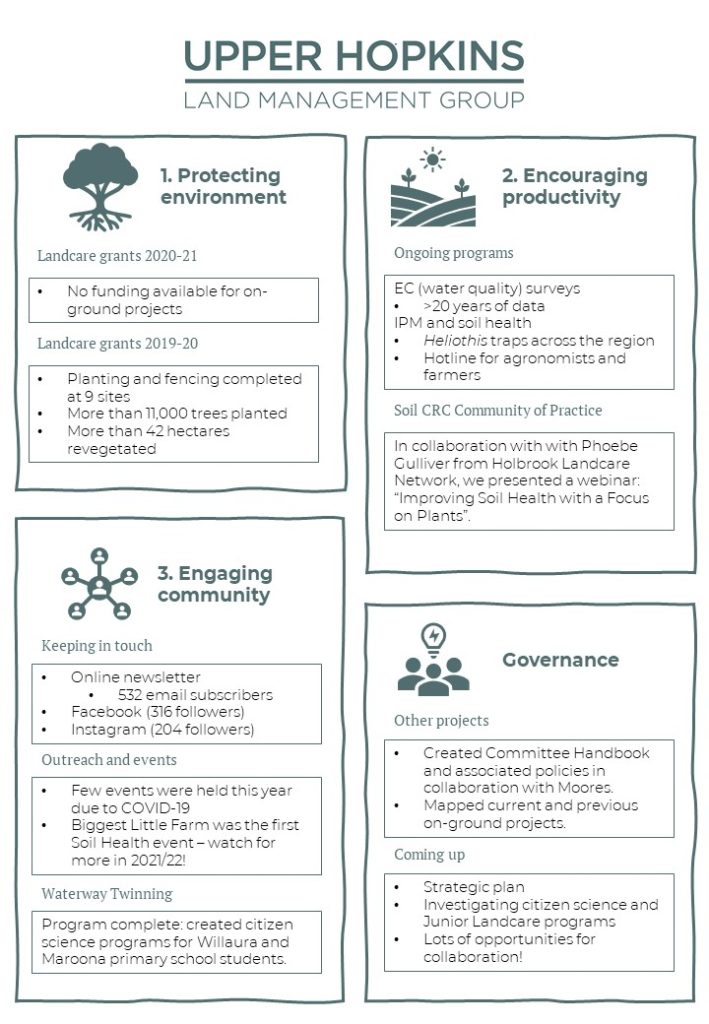
Annual grass control in perennial pastures – Enhanced Producer Demonstration Site

Over-sowing and weed control demonstration– ‘Marenda’
Wayne and Caterina are host producers for an Enhanced Producer Demonstration Site (EPDS) underway with PPS and Agriculture Victoria and co-funded by Meat and Livestock Australia (MLA).
The Burton’s demonstration site is a 24-ha paddock that was sown to a phalaris and sub clover mix in 2006. The paddock was selected for the trial because of its heavy infestation of barley grass and other weeds.
The site was set up in mid-May 2020 with the intention of controlling barley grass and at the same time, bulking up feed and extending the productive life of the paddock. The three-treatment trial included:
- Full Treatment: Over sowing, weed control and Nitrogen
- Partial Treatment 1: Over sowing and Nitrogen (no weed control)
- Partial Treatment 2: Weed control and Nitrogen (no over sowing)
Key results
A cost: benefit analysis was undertaken to compare the three treatments. The analysis included an estimate of the operational cost of treatments, inputs (including chemical and seed), hours of labour and the relative cost of the equipment. The impact of barley grass seed head contamination was beyond the scope of the project and was not included in the cost: benefit analysis. The Partial Treatment 2 (no over sowing) was used as the basis of comparison for the benefit: cost. (Refer to the full case study for the full cost: benefit breakdown).
The analysis showed a clear benefit from using both weed control and over sowing (Full Treatment) and a lesser benefit when over sowing was undertaken without weed control (Partial Treatment 1). This highlights that the minimal cost of weed control was justified by the additional benefits it gives to production.
The benefits of the Full Treatment (over sowing, weed control and Nitrogen) is summarised in Table 1. The Full Treatment increased dry matter production throughout the season leading to the highest return per hectare, followed by Partial Treatment 1 (no weed control). The effectiveness of controlling barley grass was measured 5 months after the treatments in May 2020 through seed head counts for the three treatments. The results showed that weed control was very effective on this site with both the Full Treatment and Partial Treatment 1, however seed counts were high in Partial Treatment 2 (no weed control). Over-sowing without weed control did little to reduce the amount of barley grass present.
Table 1: Summary of treatment benefits
| Treatment | Treatment description | Dry Matter Production | Seed head counts /ha | Extra benefits above Partial Treatment 2 |
| Full Treatment | Over sown, weed control and Nitrogen | 4851kgDM/ha | 250,011 | $842/ ha |
| Partial Treatment 1 (no weed control) | Over sown and Nitrogen | 3754 kgDM/ha | 4,020,989 | $345/ ha |
| Partial Treatment 2 (no over sowing) | Weed control and Nitrogen | 2194 kgDM/ha | 464,305 | N/A |
Producer feedback
Wayne is happy with the results and the comparative feedback from the different treatments. “Absolutely, I will do this again. The early break in 2020 meant the clover was big enough to spray, which was contributed to the good success.
The 2020 trial sites are still looking good and the barley grass control is evident 12 months later. I’m looking forward to seeing the seed head counts this month (October 2021). There is still some barley grass, but it’s certainly not a carpet. Ultimately, I would have liked to treat the paddock again this year with propaquizafop but it was too wet in winter to get on, so I will have to follow up and possibly look at topping again in late this spring.”
Click here to read the full report.
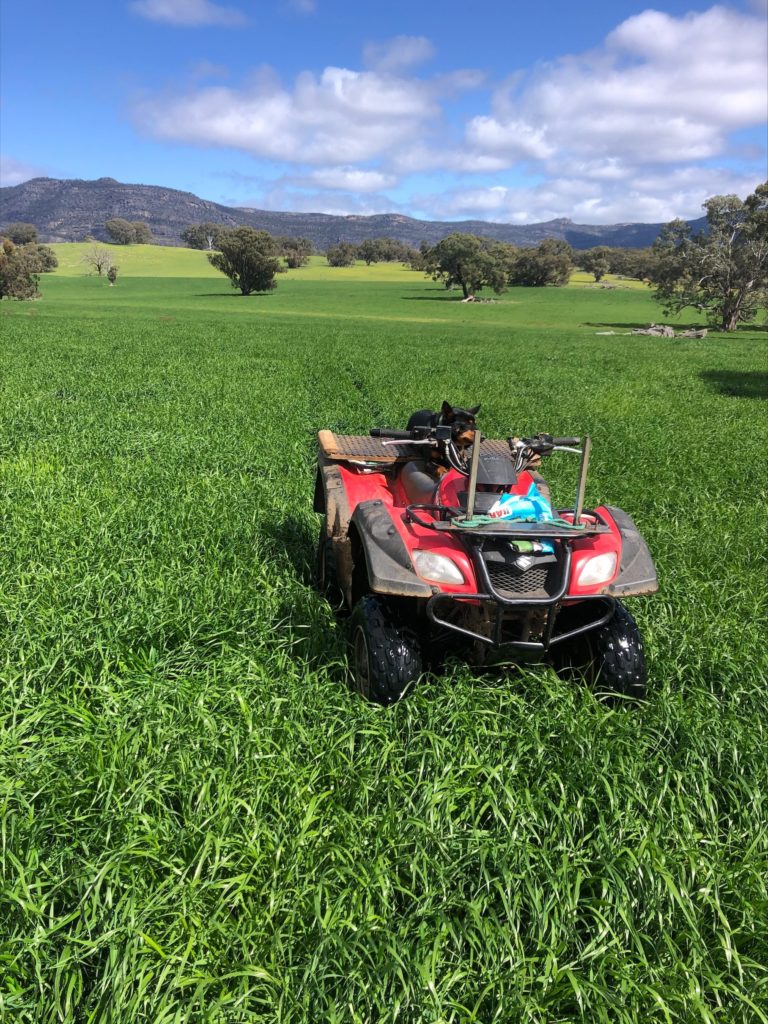
Dung beetle field day

Jayne Drum, Soil Health Committee
Recently, Southern Farming Systems (SFS) hosted a dung beetle field day at Inverleigh. The field day was part of a two-year funded project through the MLA, delivered by Barabool Hills Landcare Group and SFS.
Russ Barrows (Charles Sturt University) presented information on dung beetle activity, their life cycle, and their role in soil function. Live dung beetles were on display, demonstrating their activities at depth in the soil.
Dung beetles break down livestock manures and transport nutrients throughout the soil profile (sometimes down to 1m). They can improve nutrient cycling, feed soil biology, develop soil structure, increase soil water holding capacity and reduce pasture spoilage. They can also sequester carbon in the soil and reduce populations of flies and parasites.
SFS is partnering with two additional Landcare groups in the Geelong area on another dung beetle monitoring project, made possible with a 2021 Victorian Landcare Grant. The project will involve trapping to assess the diversity and abundance of dung beetles in their region over a 12 month period.
The Upper Hopkins LMG Soil Health subcommittee has been investigating how dung beetles could benefit our local landscape. If you are interested in learning more about dung beetles, please let us know.
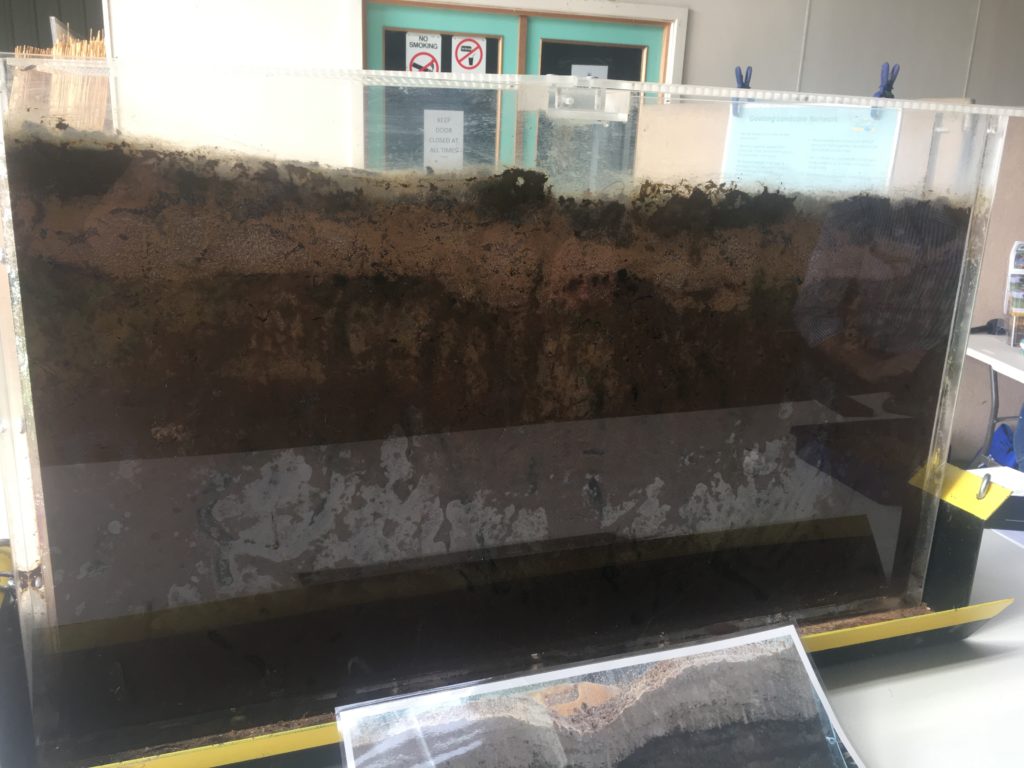
This soil cross section includes live dung beetles, showing activity of dung beetles as depth, to 40 cm in this display 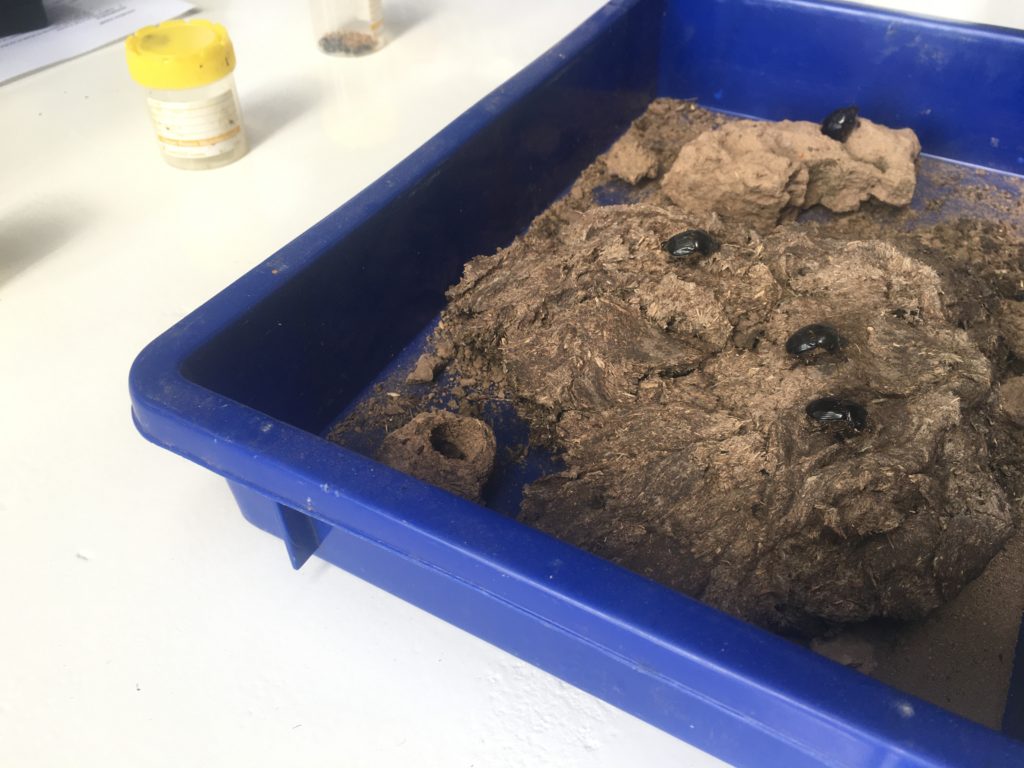
Dung beetles can easily be trapped for identification and population counts in a shallow container.
World Soil Day 2021 – Managing Soil Salinity

Richard Murphy, Land Health Coordinator
World Soil Day will be recognised on Sunday 5 December 2021, and this year’s theme is, ‘Halt soil salinisation, boost soil productivity’. Historically, dryland salinity has been a major threat to soil health and farm production in the upper Hopkins region. In 2005, Glenelg Hopkins Salinity Plan identified large areas of the granite hill country and volcanic plains to be at high risk of degradation from dryland salinity.
For the most part, dryland salinity results from the removal of native vegetation for agriculture. Rainfall, previously captured by deep-rooted trees, shrubs and grasses, percolates beyond the shallow roots of pastures or crops, into groundwater causing water tables to rise. At the soil surface, evaporation causes salt from even slightly saline groundwater, to accumulate. Degrading the capacity of soil particles to stick together, soil at groundwater discharge sites become unproductive and easily eroded.
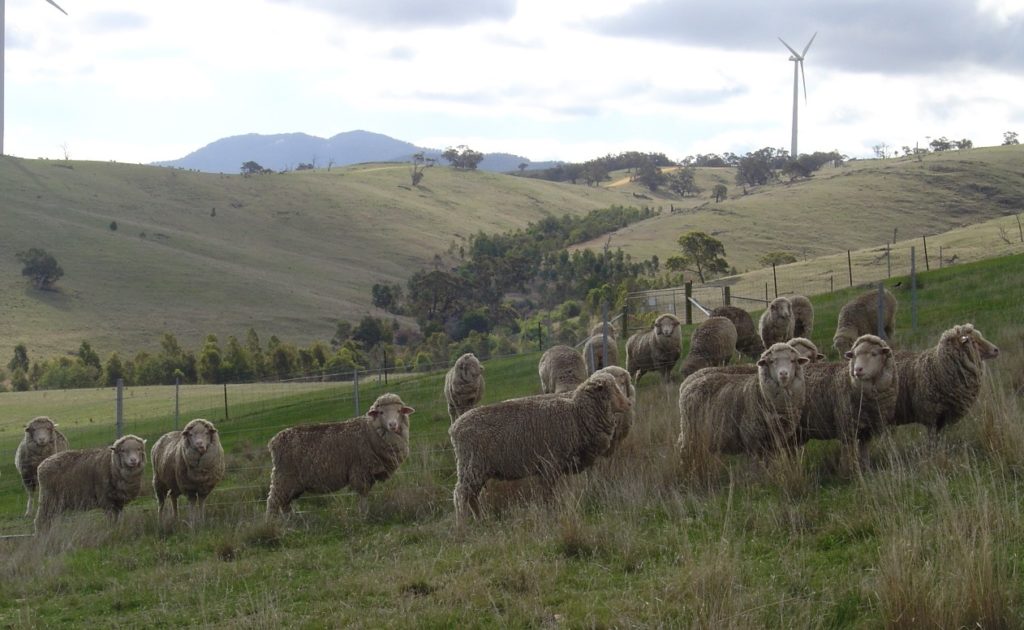
Deferred grazing, gully tree planting and perennial pastures have reduced dryland salinity in the Upper Hopkins. (photo supplied)
By 2005, observed expansion of dryland salinity prompted government and community action to halt, even reverse this process. With leadership from upper Hopkins’ locals such as Debbie Shea and others, the Glenelg Hopkins Salinity Plan set out actions to increase uptake of infiltrating rainwater and lower groundwater tables. Glenelg Hopkins CMA, in partnership with Agriculture Victoria, Upper Hopkins Land Management Group and Perennial Pasture Systems, plus the assistance of Land Mate prison work crews, implemented a program of tree planting, sowing of deep-rooted perennial pastures, deferred grazing of hill tops and fencing of discharge sites and waterways.
Today, dryland salinity remains a concern for many landholders but it not the menace it once was. It is interesting to note that, over this same period, dryland salinity has retreated across all parts of Victoria. So, was this victory the result of an awesome Salinity Plan and dedicated community action or was it just good luck, part of a cycle that we are currently in a natural low point?
Like soil degradation, climate change happens so slowly it is easy not to notice.
Reduction of total annual rainfall is a forecast outcome of a changing climate. Less rainfall means less infiltration to groundwater tables and decline in occurrence of dryland salinity. Bureau of Meteorology weather station data at Ararat, Wickliffe and Lake Bolac reveal annual rainfall totals from 1990 to 2020 have fallen by 9%, 10% and 14% respectively. Areas that have enjoyed decline in dryland salinity, sometimes despite changing landuse from permanent pasture to cropping.
There is no doubt that land manager actions have contributed to the decline of dryland salinity in the upper Hopkins catchment however, a changing, drier climate may also be playing a role.
While the observed reduction in salinity is cause for celebration, this win may be confirmation of challenging, drier times ahead.
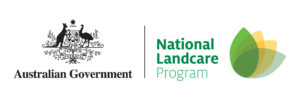
The Glenelg Hopkins Sustainable Agriculture Project is funded by the Australian Government’s National Landcare Program.
Upper Hopkins LMG – Annual General Meeting

Heather Fleming
This article is reprinted with permission from the Ararat Advocate.
The Annual General Meeting of the Upper Hopkins Land Management Group was held recently.
The Group cares for approximately 250,000 hectares of land that extends from Ararat towards Beaufort, south to Chatsworth and west to Yarram Gap and Moyston.
It has been operating for the past thirty years and has been steadily working on its mission of “Protecting the environment, encouraging productivity, engaging our/the community to ensure sustainable farming for current and future generations.”
Facilitator Ayesha Burdett noted that while no funding was available via the Victorian Landcare Grants for 2020-21, the group did receive funding for four projects in 2019-20 and all of these were completed.
The Group applied for funding for four projects in the upcoming year, and was successful in each of these requests. They included works to protect the Hopkins catchment, the expansion and protection of bio-diversity corridors, and a project to look at diversifying agricultural landscapes across the Upper Hopkins Land Management Group region.
This year the Soil Health subcommittee held a screening of “Biggest Little Farm” at the Willaura Memorial Hall, and now that COVID restrictions have eased ‘Hands-On’, paddock-based workshops are planned for 2021-22.
Citizen Science events (“waterbug blitzes”) were conducted with Willaura and Maroona Primary Schools and these were popular events.
Ayesha Burdett concluded her report by saying, “COVID-19 has altered the way we do some of our Landcare work, and has given me access to a lot more resources online (especially webinars and out-of-town meetings). However, I am extremely relieved that restrictions are easing and we can once again plan to get together and learn from one another about sustainable production and caring for our environment.”
President Jack Tucker noted in his report that the Covid-19 pandemic had provided obvious challenges over the past twelve months. He said however, “In a way it has probably created an opportunity for people to slow down, take stock and seriously consider getting on with landcare projects.”
A successful activity that was able to proceed was an Integrated Pest Management day held on a local farm. Jack said, “It was a great opportunity for local agronomists and farmers alike to draw on the vast knowledge and experience of well known Ag entomologist Paul Horne.”
Finally Jack noted, “As always I will finish my report by reminding everyone to encourage others to join the committee as it is important that we continue to have people with a diverse range of experience and skills leading the group. Alternatively if members of our Group have a particular interest we would welcome their input big or small.”
Guest Speaker for the evening was Dr Inka Veltheim. For over ten years she has been studying the movements and resource use of brolgas, which are a threatened species in Victoria.
She has focussed her studies on the wetlands near Willaura, and hopes the outcomes of her research will be used to protect key habitat areas and movement corridors for these beautiful birds.
The day after the AGM Dr Veltheim led a wetland walk through a local farming property, and was able to show a large group of interested people the habitat brolgas prefer, and how farmers have been protecting and enhancing these habitats as part of their farming operation.
The group were lucky enough to spot several brolgas in flight and all appreciated the opportunity to learn firsthand from an expert like Dr Veltheim.
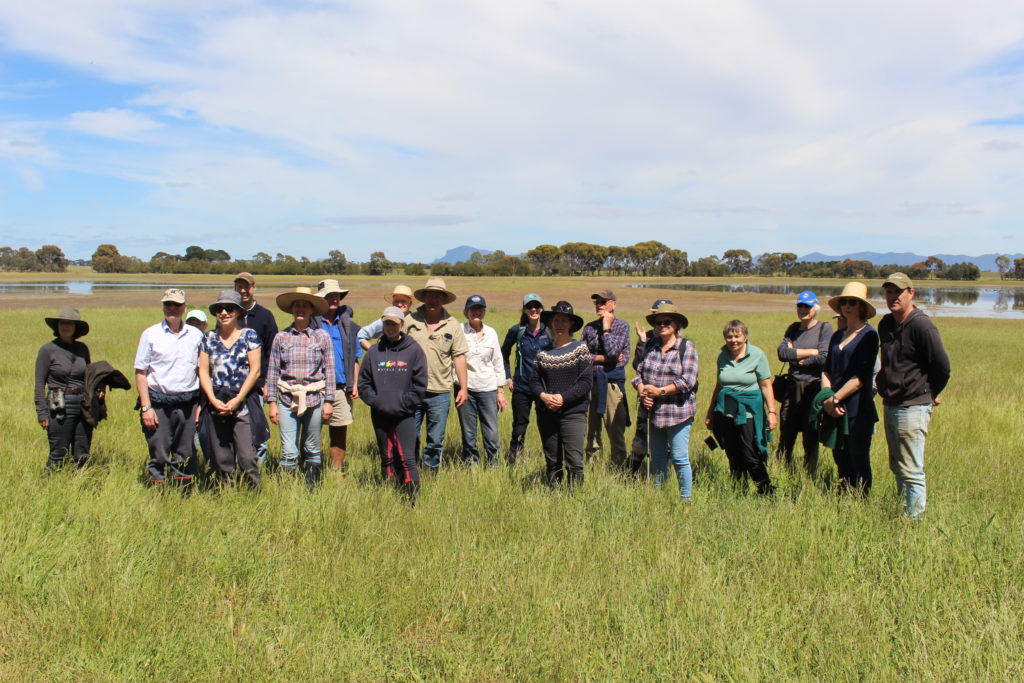
Victorian Serrated Tussock Working Party seeks community representatives to stop the spread of tussock
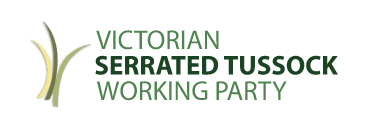
Ivan Carter, Community Engagement Officer
Would you like to be a valued Community Representative on the Victorian Serrated Tussock Working Party (VSTWP) Committee, and be remunerated for your time?
The VSTWP are a state-wide community organisation that have historically focused efforts on containing the core infestation of the noxious weed Serrated Tussock (Nassella trichotoma) to the north and west of Melbourne. They are aiming to increase support in the West Gippsland, North-East and South-West Victoria region, and as such are seeking a point of contact from each region to sit on the committee. Serrated tussock infestations are spreading throughout Victoria, and better representation and assistance available is important for all regions.
Serrated tussock is an introduced invasive plant from South America that rapidly decreases the biodiversity of native grasslands and seriously reduces the agricultural capacity of properties. Chairman of the VSTWP Lance Jennison said “Serrated tussock now covers over 250,000 hectares of land in Victoria and has caused heartache for many landowners battling the invasive grass”. “The VSTWP is an incorporated organisation comprised of community members in collaboration with a range of stakeholders, including members of the State Government, Catchment Management Authorities, Local Government, Landcare, VicRoads and Vline/VicTrack” said Mr Jennison.
In 1995 the community was deeply concerned with the spread of serrated tussock, a devastating weed that had invaded 140,000 ha of land in Victoria. In response to that community concern, a strategy for the control of serrated tussock in Victoria was produced, which called for the development of the Victorian Serrated Tussock Society, as it was known then. Today, that organisation is the community-managed and driven Victorian Serrated Tussock Working Party (VSTWP).
Committee members are invited to quarterly meetings (4 per year) and are required to attend at least 50% of these. Meeting attendance may be in person or via video or online meeting platforms. The Working Party also establishes technical or advisory groups to address specific tasks/issues between meetings, and make use for email and telephone to collaborate.
Community representatives come from various walks of life with differing skills and experience; all with an interest and concern about serrated tussock in Victoria. It is the community representative’s responsibility to meet the outcomes of the Victorian Serrated Tussock Strategy 2018-2023 by educating, promoting and encouraging the Victorian community to adopt serrated tussock best management practices. Community representatives will be reimbursed for their time attending VSTWP meetings in accordance with Victorian Serrated Tussock Working Party ‘sitting fees and travel rates schedule.’ Community representatives will also be reimbursed for kilometres travelled by car and other travel costs such as parking or public transport to attend VSTWP meetings and attending approved events.
The VSTWP have also recently upgraded their website (www.serratedtussock.com) to include a series of video clips that assist landowners with the identification of serrated tussock and provide video case studies of successful serrated tussock management in Victoria. The website also has a variety of research on best practice management and copies of the iconic quarterly newsletter the Tussock Times.
For further information about joining the VSTWP, please contact Ivan Carter, Community Engagement Officer, Victorian Serrated Tussock Working Party on 0422605953. For more information on serrated tussock please visit www.serratedtussock.com.

Serrated tussock treated south of Gisborne, with the selective herbicide Fluproponate 
Serrated tussock in seed, note the small purple seeds
FINALLY! GHCMA field days are in full swing again

Aggie Stevenson, Senior Biodiversity Officer
It’s been a long time since we have been able to host local field days. Our drought was finally broken on Monday 22 November, when 30 keen people attended the first GHCMA grassland field day held in two years, south of Ararat.
The day began at Peter and Jenny Hinchliffe’s property, which has over 50ha of pristine Natural Temperate Grassland on the rolling hills. The site is host to one of the new populations of the endangered Button Wrinklewort (Rutidosis leptorhynchoides), which generated many questions about establishing new populations of threatened species.
Dr Brad Farmilo, from the Arthur Rylah Institute (ARI) spoke to the group about grassland monitoring, covering topics such as why it is important to do, and how it is done. This helped attendees understand the importance of active management in native grasslands, and that the concept of ‘fence off and forget’ certainly does not work.
After enjoying lunch and being around like-minded people, the group moved down the road to the property of long time campaigners, Pete and Christine Forster, who have been working on their block at Bullock Hills since 2001. This site is an excellent example of what can be done with more than just a little elbow grease, and a lot of determination! The area was once covered predominantly by Cape Weed, but now hosts a beautiful replica of what would have once been a Grassy Woodland, with grassland understorey. Pete talked about the ongoing battle of trying to keep the South African Weed-orchid population down, of their past battle with rabbits and their efforts of burning the site to maintain low biomass levels in their grassland site.
The day was well-received by all who attended, with people commenting on how good it was just to get out and have a look at what their neighbours are doing, and finding out how other people deal with certain weed issues.
A big thank you to Peter & Jenny and Pete & Christine for their hospitality on the day.
editor’s note: There is a short video from the site visit that will introduce you to the Lonely Button Wrinklewort – see more on Facebook (https://www.facebook.com/buttonwrinklewort).
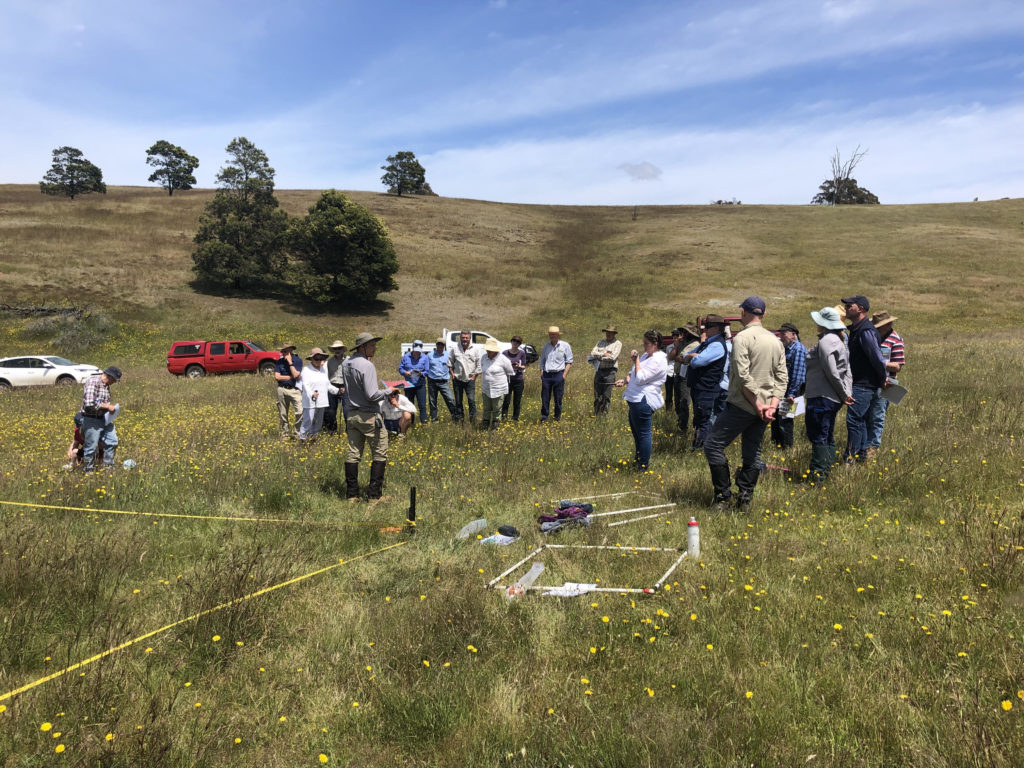
Group at Peter and Jenny Hinchliffes grassland 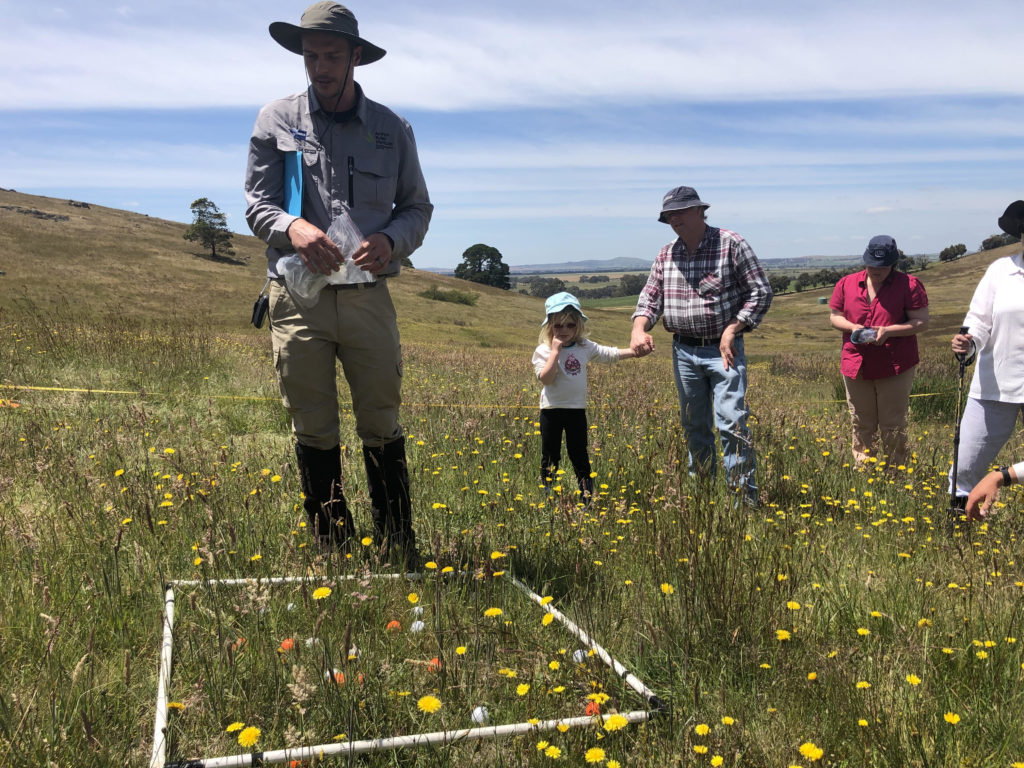
Dr Brad Farmilo (ARI) speaking about the grassland monitoring program 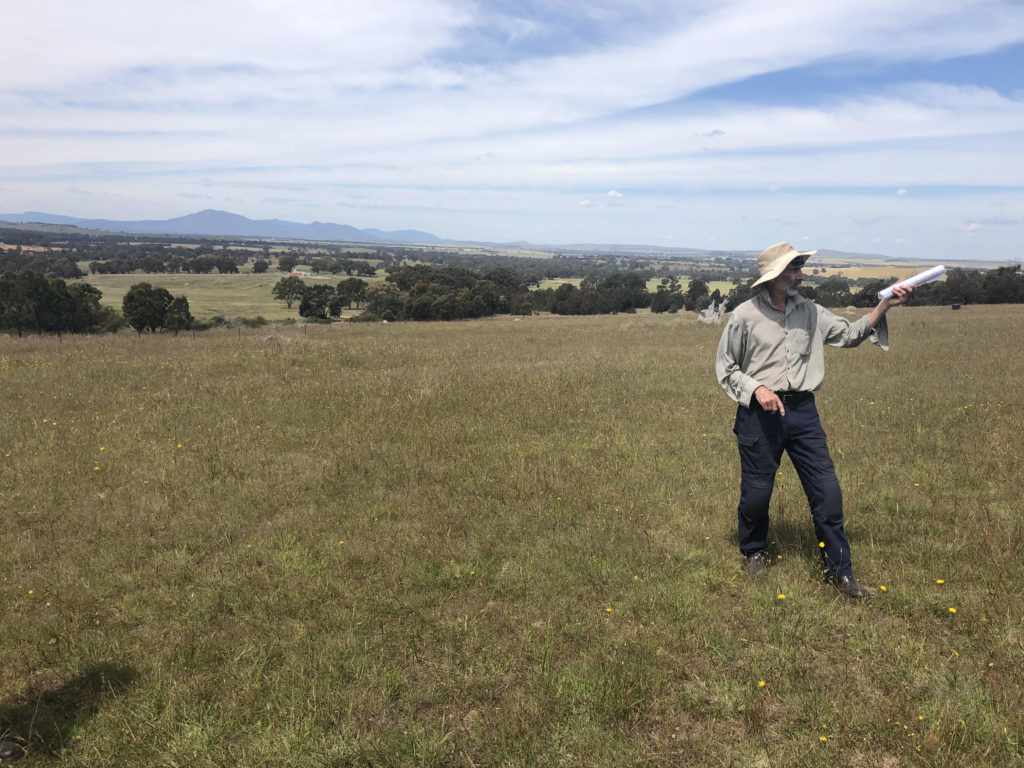
On Friday 26, almost 24 participants braved much chillier conditions to attend a wetland field day hosted by Michelle and Anthony Casanova and Rob Coutts, an active VVP Stewardship participant. Dr Kay Morriss from the ARI talked to the group about the Wetland Intervention Monitoring Program (WIMP) and how ARI staff are trying to determine the ‘best’ grazing strategy for wetlands… this is much harder than anyone seems to realise! Kay and Michelle took groups through the process of doing WIMP monitoring at Rob Coutts wetland at Mininera, which had a gorgeous display of Fairie’s Aprons (Utricularia beaugleholei) to keep everyone happy.
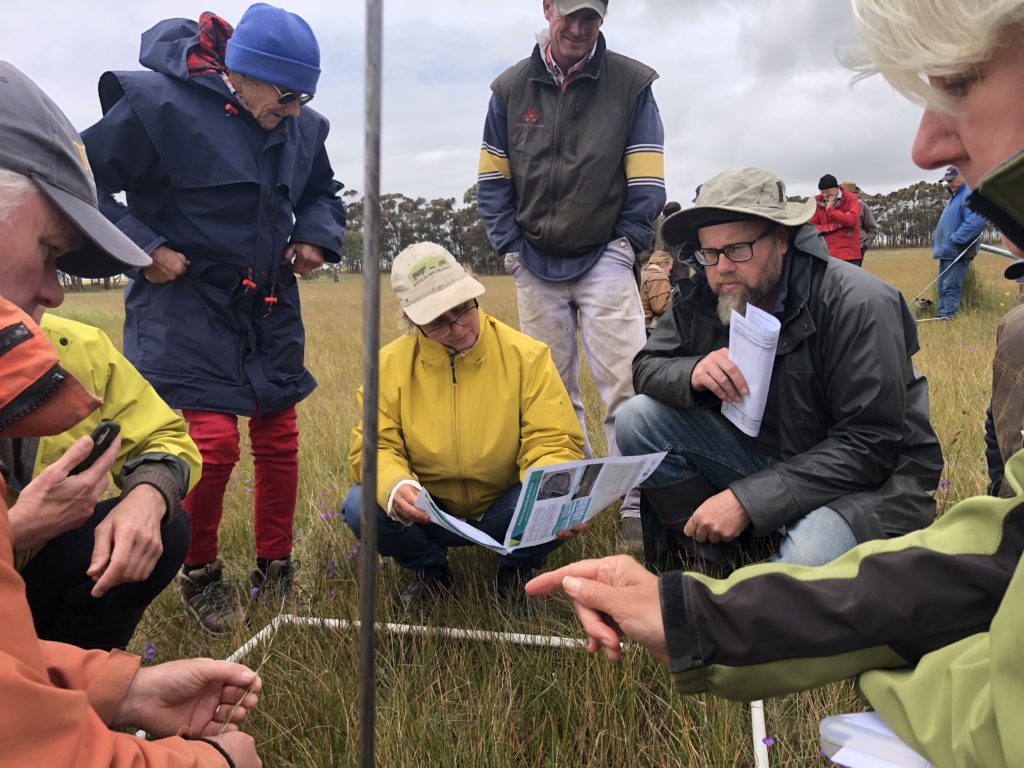
Wetland Intervention Monitoring Program 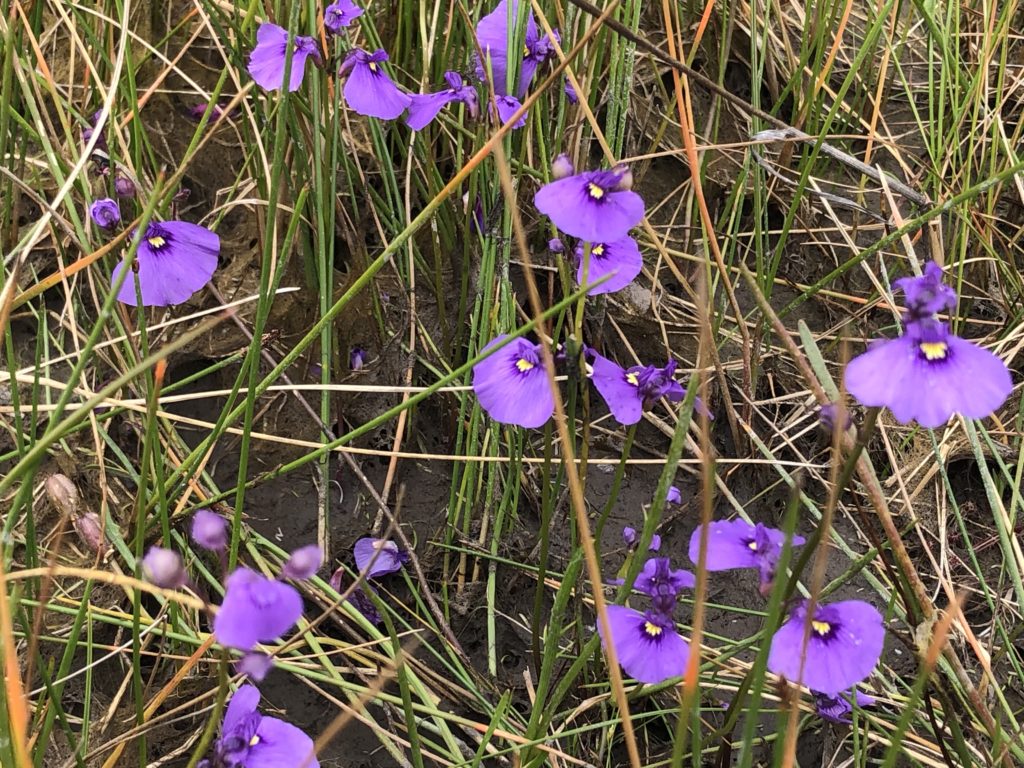
Fairie’s Aprons (Utricularia beaugleholei)

This project is supported by Glenelg Hopkins CMA, through funding from the Australian Government’s National Landcare Program.
Integrated Pest Management (IPM) field day

In October, the Upper Hopkins Land Management Group joined Paul Horne for a field day to learn about current monitoring practices for Heliothis (Helicoverpa punctigera and armigera) and some new monitoring tools for Heliothis and fall army worm. We were fortunate to visit the Willaura South Heliothis monitoring site, and scout the neighbouring crops for insect pests and predators in faba beans and canola.
The goal of the workshop was to familiarise participants with the collection and identification of these insect pests, and their potential impacts on crops in our region.
We had eight enthusiastic participants at the workshop, newly released from the October COVID restrictions. Most people had received IPM training a long time ago, or never before, so Paul Horne did a great job introducing everyone to the key invertebrate pests in faba beans and canola crops. There were Heliothis in the traps (both H. armigera and H. punctigera), so we had a good discussion about the value and limitations of monitoring.
Everyone agreed that they learned something new from the workshop, and many people highlighted the value of learning about insect life cycles.
The Soil Health Committee is planning several more hands-on workshops in the new year – stay tuned for dates and details!
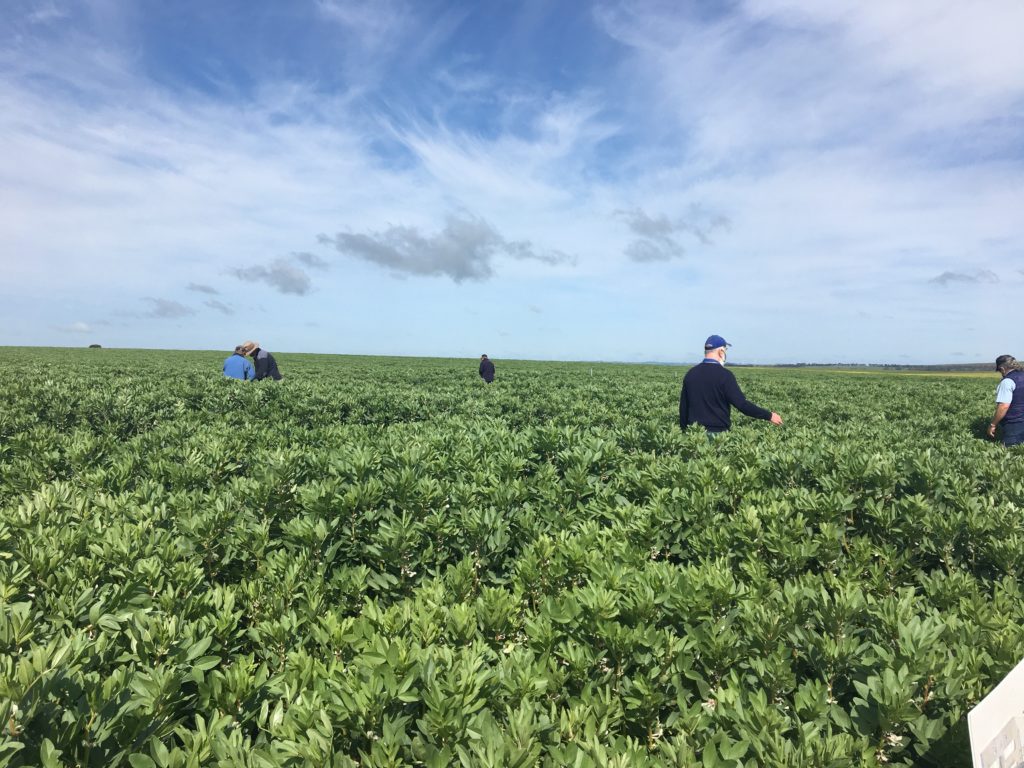
Searching for pests in faba beans 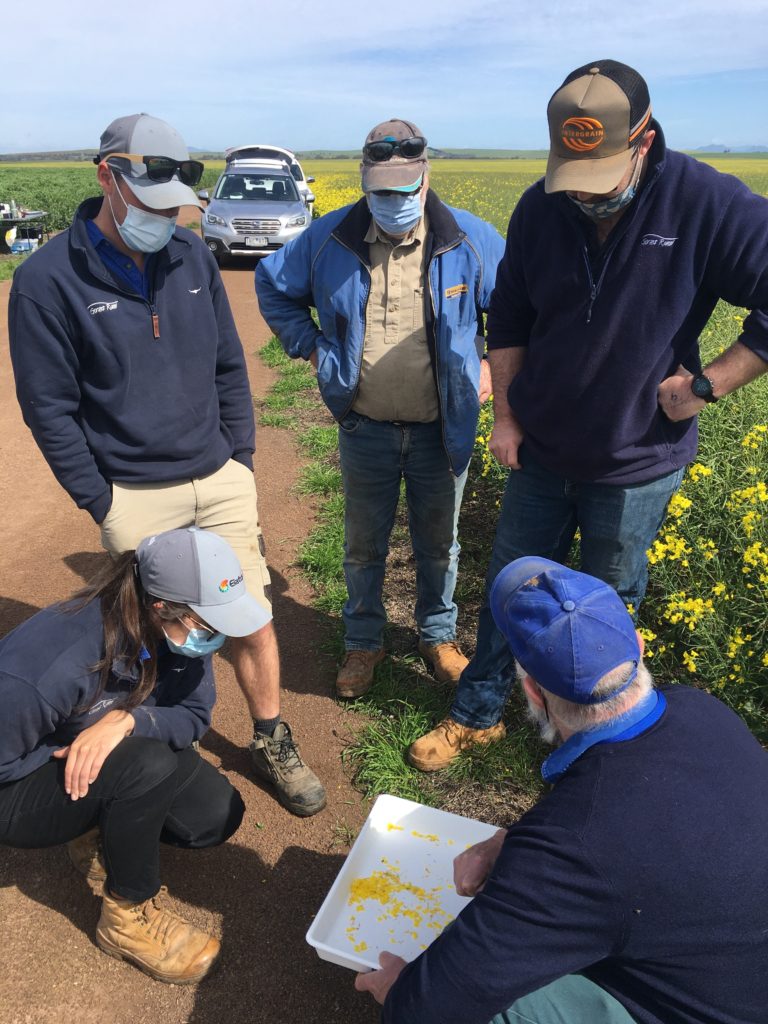
Discussing integrated pest management options

This projects is supported by Glenelg Hopkins CMA, through funding from the Australian Government’s National Landcare Program.
Updates from Southern Farming Systems
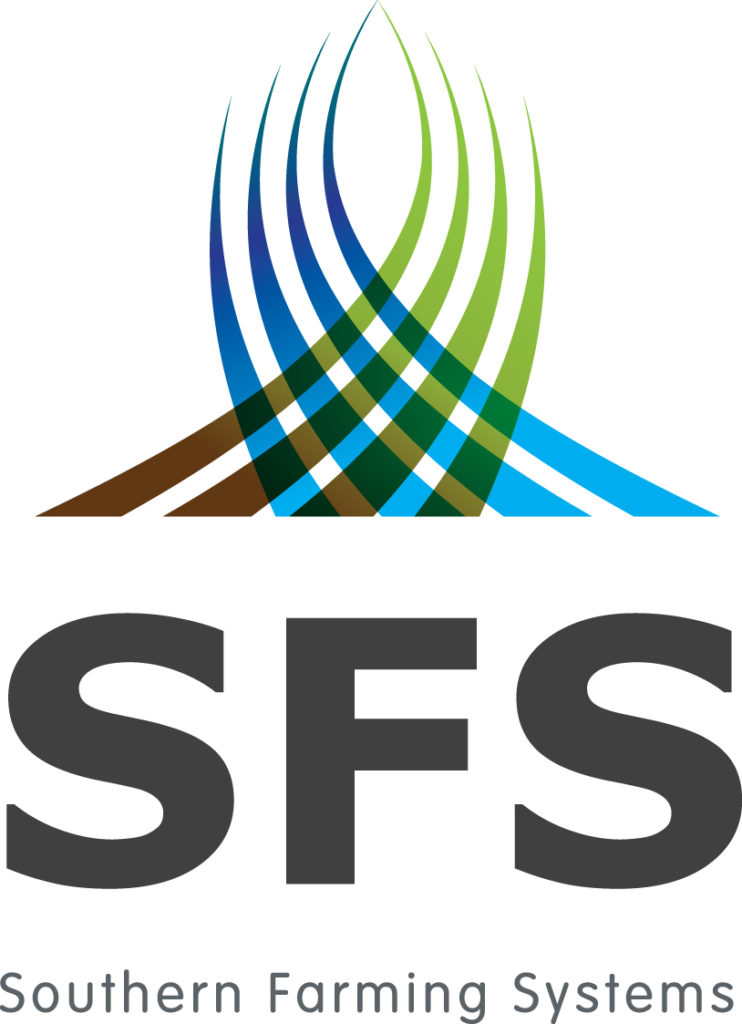
By Michelle McClure, SFS Events and Communications Coordinator
E:mmclure@sfs.org.auor M: 0488 600692
Southern Farming Systems is proud to be involved in the National Government’s Future Drought Fund as a lead on the South West Node. For more information about the project read here..
Building Drought Resilience – Get on board!
Ever wondered what impacts climate change may have on your farming business?
What will it do to crop yields, pasture growth and farm profit?
Are you prepared to make changes to your business in response to climate change?
Now is the time to get ahead and take charge of your farm’s profits!
Southern Farming Systems have received funding from the Australian Government’s ‘Future Drought Fund’ to analyse 32 cropping and livestock farms in Southwest Victoria so we can understand the likely impacts of climate change predictions across a range of farming operations.
The core of the project is to develop a profit risk profile for each participating farm business, showing the current range in profits, and the probability of these profits occurring. Farms will be analysed individually, and we welcome cropping, livestock, and mixed farm participation.
Once all 32 farm analyses have been completed, then using computer modelling we will test the likely effects of climate changes and how they financially impact your farms business. There will also be opportunities to join discussion groups to look at the possible climate solutions for your farming business.
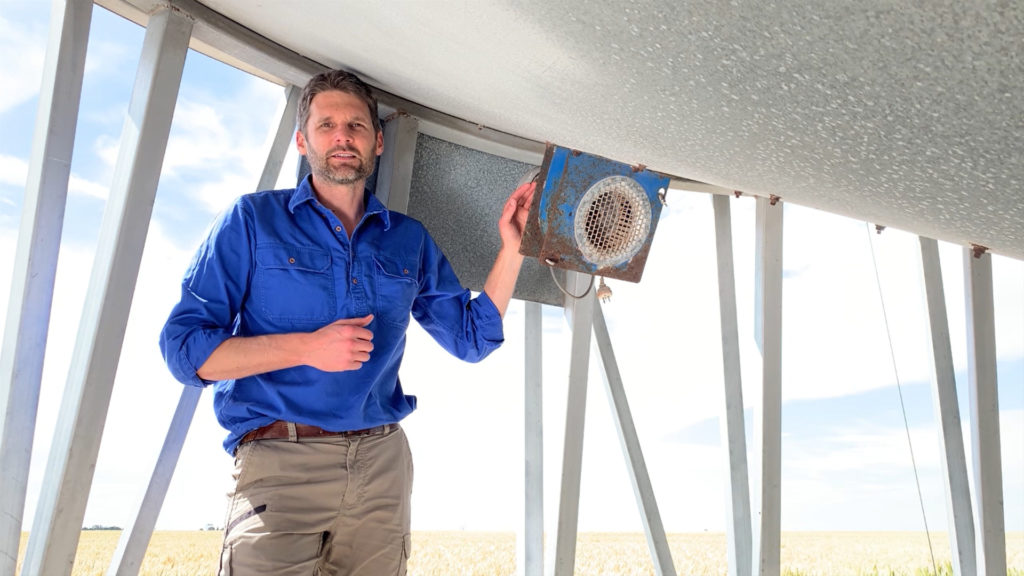
The cost to participate is $550 per business.
For more information checkout the video https://youtu.be/IfkJ1aosJ-o or contact Tahlia Ferguson to register your interest TODAY!
E: tferguson@sfs.org.au or M: 0418 462 967 during business hours.
Aeration cooling can help save moist grain
With substantial yields expected across much of the Australian grain growing area and wet weather hampering harvesting efforts, growers are being encouraged to consider how they will manage on-farm storage to preserve grain quality. Storing cereals and pulses with an average moisture content above 12.5 per cent can cause a range of issues, including mould and insect outbreaks in storage facilities. Read More Here…
What do you know about fungicide resistance?
You’re probably using or recommending fungicides to help control crop diseases – but are those same diseases using you to enhance their ability to fight back?
Fungicide resistance can evolve anywhere. So AFREN wants to know how well Australian growers and advisers understand the causes and controls. Whether you consider yourself an expert, a responsible fungicide user, or just want an idea of how your current knowledge measures up, your participation will be valuable to AFREN’s ongoing fungicide resistance extension work.
Tell us what you know – and what you’d like to know more about. Take 15 minutes to be part of the AFREN fungicide resistance survey here.
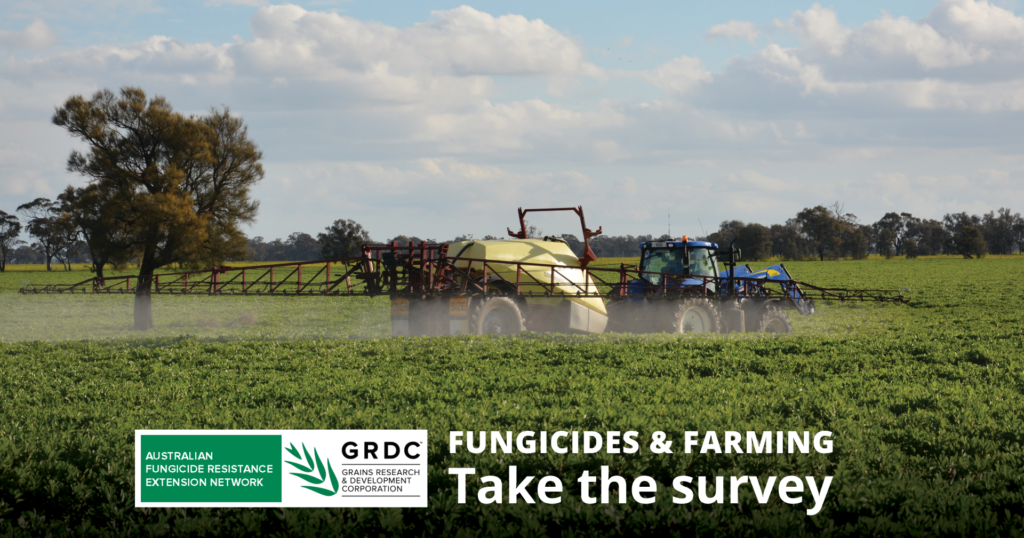
The Virtual Extension Officer website is here!
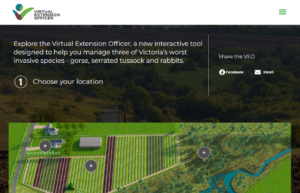
The Virtual Extension Officer website (VEO) is a free, online resource to assist landholders, land managers, professional pest controllers, biosecurity groups and community groups, manage serrated tussock, gorse, and rabbits on their property.
Developed by the Victorian Gorse Taskforce in collaboration with the Victorian Rabbit Action Network and the Victorian Serrated Tussock Working Party, this website brings all our expert knowledge about these three species together in the one, easy to use place!
Rabbits, gorse, and serrated tussock are widespread in Victoria and impact agricultural productivity and the environment. We all need to work together to manage these devastating pests, but it can be difficult for people to know when and where to use the right control methods.
We want people to feel empowered to control these pests so we can reduce their impact across the state and so the VEO was born!
The VEO was developed to enable landholders battling any one of these species, to replicate their individual situation online and gather relevant information, in a quick and easy way, without leaving their home. No need to search through multiple resources and websites for the right information or how to apply it in your situation, the VEO website provides a step-by-step guide to assist you in finding the right management options for your property.
It’s just like having your own personal extension officer in your pocket!
So how does it work?
In as easy as four clicks of a button, the user can choose a property location, species, infestation size and type of control they are interested in, and the VEO will advise the most appropriate methods of control.
We know you will find value in this website and we would encourage you to please share it amongst your networks.
The VEO is very easy to use and compatible with most smart devices.
The website can be accessed at www.virtualextensionofficer.com.au.
Funding for the website was provided by the Australian Government Agricultural Competitiveness White Paper in collaboration with Agriculture Victoria.
For more information please contact the Victorian Gorse Taskforce at info@vicgorsetaskforce.com.au
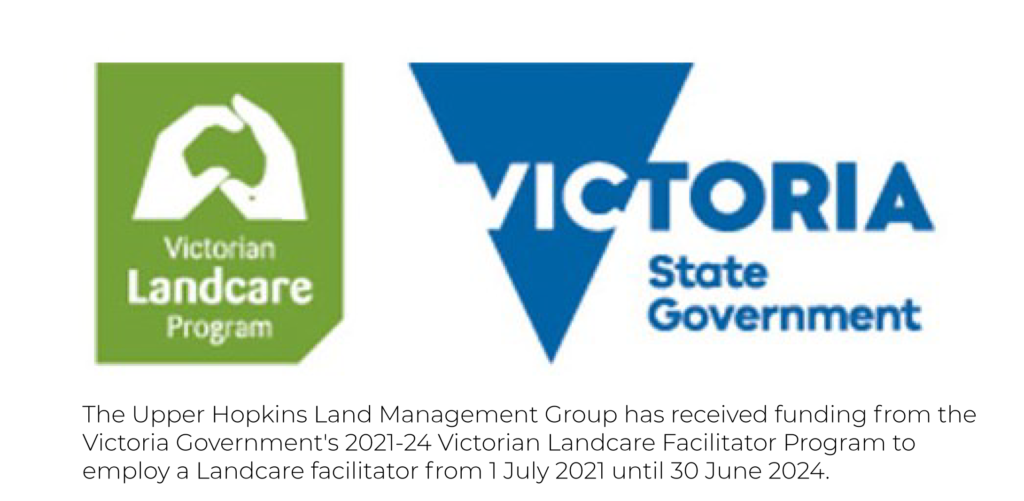

Meanderings and reflections
Most of our little creeks and rivers are still flowing after the long, wet winter, but water levels are starting to drop at some sites.
There was a ridiculous amount of invertebrate life at the Rossbridge Wildlife Reserve – I managed to scoop up a beautiful damselfly, aquatic snails, a water snipe fly larva, scuds, copepods. There was even a bunch of fish swimming in there (Gambusia – mosquito fish). All of this life buzzing about made me extremely excited! This site is usually quite salty, and the waterbugs that I saw are all pretty tough and tolerant of poor water conditions.
I also spotted some spoonbills (one Royal Spoonbill, one Yellow-Billed Spoonbill) hanging out at a wetland near Tatyooon. The Royal Spoonbill is such a handsome fellow! It looked like each of the spoonbills had “borrowed” a swan’s nest. I couldn’t tell if the swans were happy about this or not…
Finally, I noticed that the brolgas are starting to move into the area for the summer. What a great time to be out and about to see all of this birdlife!
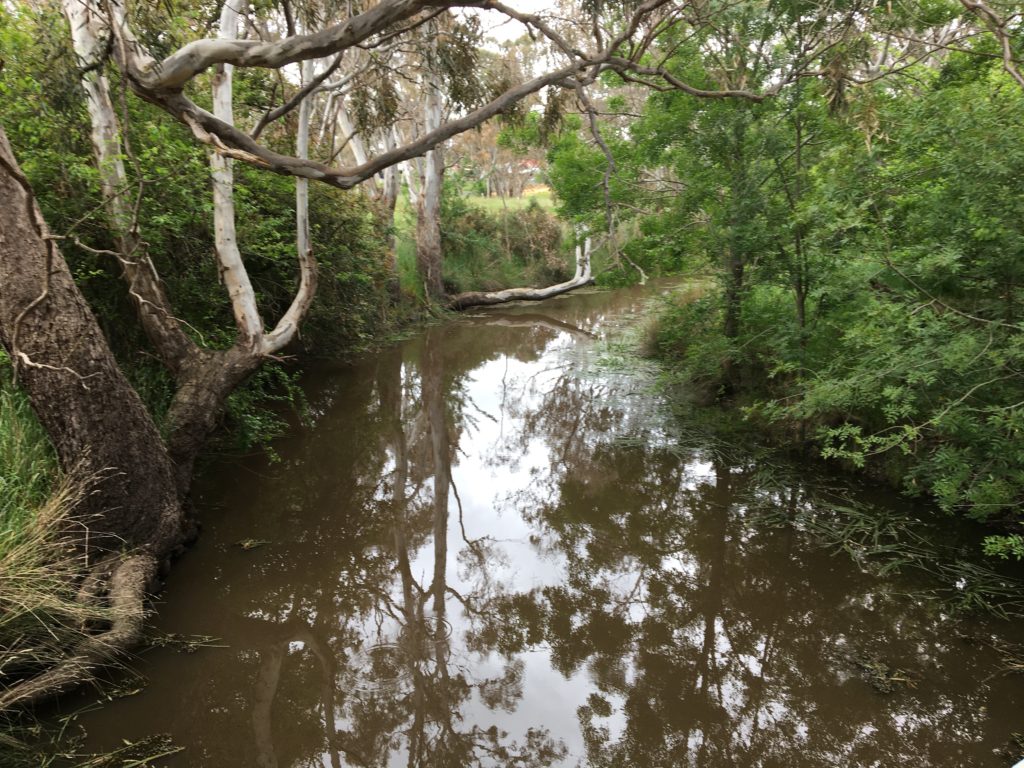
Buangor bridge 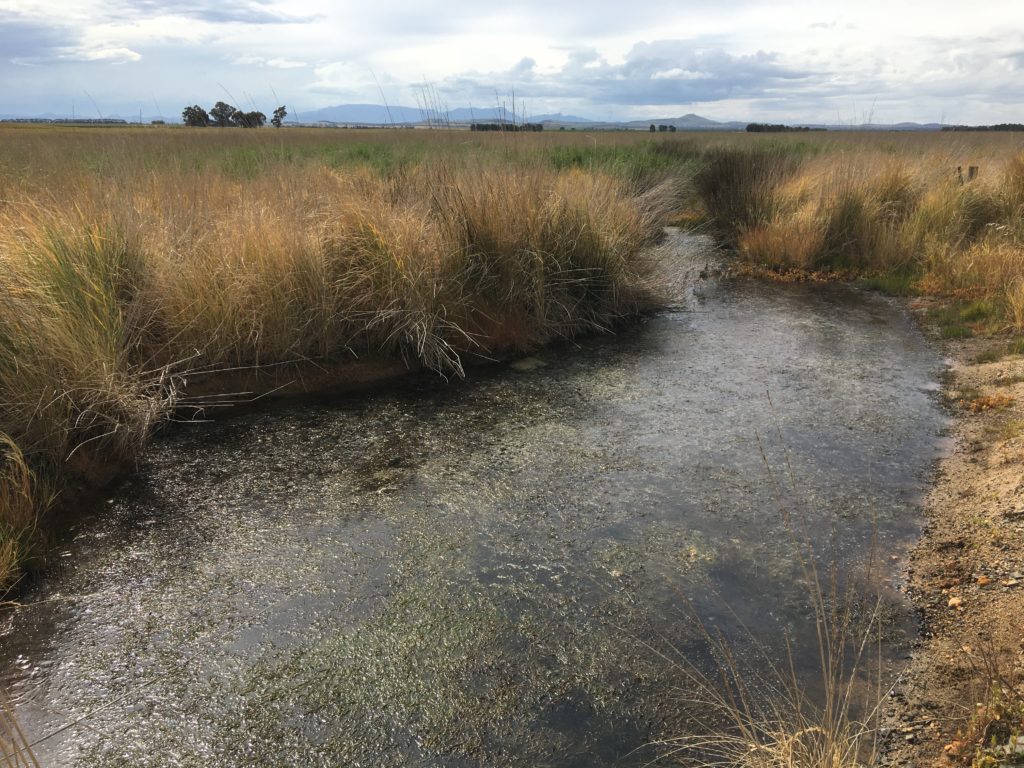
Rossbridge Wildlife Reserve 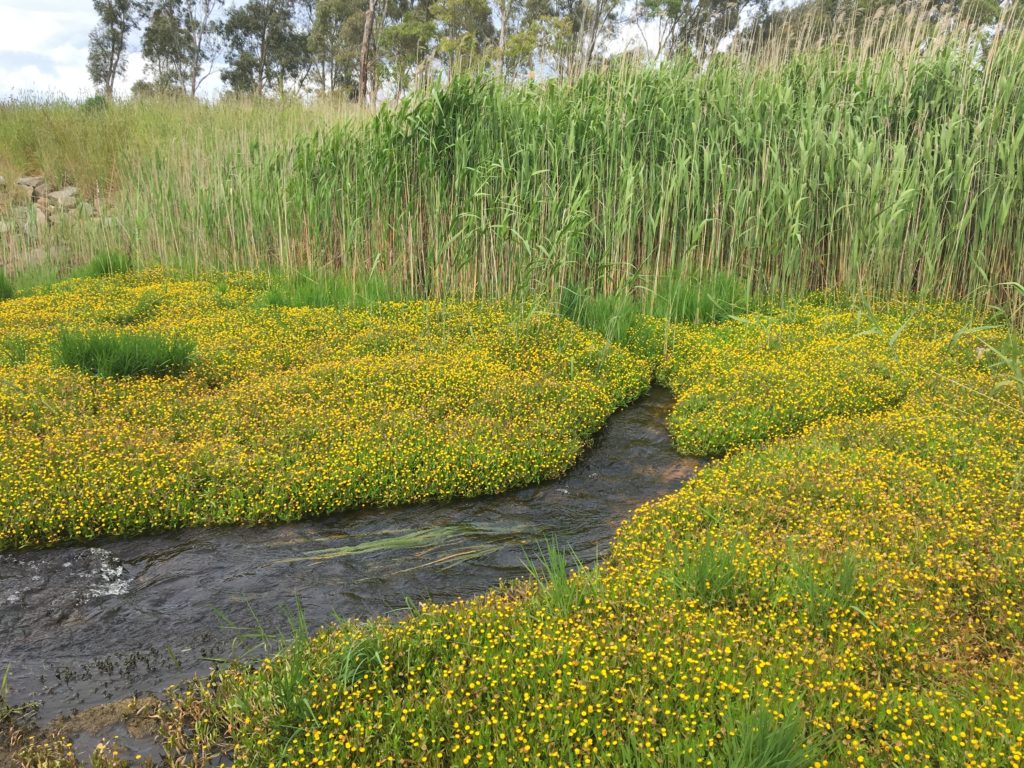
Under the bridge at Rossbridge
Water monitoring results
You can view the EC data in the table below, or click on the link to download a file. Numbers in bold exceed 6,000 EC μS/cm.
EC levels for livestock water supplies. Value given in brackets for each type of livestock is the EC level at which production decline begins: Beef cattle (6,200 EC μS/cm), lactating ewes and weaners (6,000 EC μS/cm), dry sheep (9,300 EC μS/cm)), horses (6,200 EC μS/cm), Pigs (3,100 EC μS/cm), poultry (3,100 EC μS/cm).
